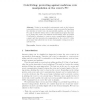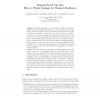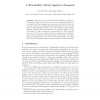80 search results - page 4 / 16 » Protecting Cryptographic Keys against Continual Leakage |
SBCCI
2005
ACM
14 years 1 months ago
2005
ACM
The physical implementation of cryptographic algorithms may leak to some attacker security information by the side channel data, as power consumption, timing, temperature or elect...
DAGSTUHL
2007
13 years 9 months ago
2007
Voting in uncontrolled environments, such as the Internet comes with a price, the price of having to trust in uncontrolled machines the collection of voter’s vote. An uncontrolle...
IACR
2011
12 years 7 months ago
2011
Abstract. Tampering attacks are cryptanalytic attacks on the implementation of cryptographic algorithms (e.g., smart cards), where an adversary introduces faults with the hope that...
DFT
2007
IEEE
14 years 1 months ago
2007
IEEE
Many side-channel attacks on implementations of cryptographic algorithms have been developed in recent years demonstrating the ease of extracting the secret key. In response, vari...
FC
2010
Springer
13 years 11 months ago
2010
Springer
Since 2004, many nations have started issuing “e-passports” containing an RFID tag that, when powered, broadcasts information. It is claimed that these passports are more secur...



